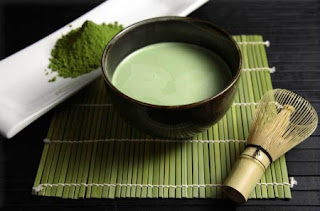Tea is the most consumed, and one the most popular, beverages in Japan. It also holds a very significant place within their history, tradition, and modern culture. Tea holds such value among the Japanese, that there is even an entire ceremony dedicated to the preparation and serving of tea, the Japanese tea ceremony. Though several different types of tea are included within the ceremony, it centers around green tea- the most commonly consumed type in Japan.
The green tea family is home to five different types of green tea. These types include Matcha, or powdered green tea, Konacha, residual green tea, Hojicha, roasted green tea, Genmaicha, green tea with roasted brown rice, and Ryokucha, the classic green tea.
Matcha, the powdered green tea, is the main green tea used within the tea ceremonies. This tea allows for only the highest quality leaves. It is prepared by drying and milling the leaves into a very fine powder, then mixing with boiling water.
Konacha, the residual green tea, is made up of tea buds, tea dust, and small leaves that remain after processing. Though considered a lower grade tea, it is still well-liked and considered a great compliment to certain dishes, such as sushi.
The roasted Hojicha tea is loved for its sweet, almost candy-like aroma. This is caused by the heat from the roasting process triggering the leaves to undergo chemical changes. It is also characterized by its distinctive reddish-brown color.
Has your family received a Nook, Kindle or iPad this year? Find Fujimini Adventure Series award-winning books here. Great family-friendly gifts
Has your family received a Nook, Kindle or iPad this year? Find Fujimini Adventure Series award-winning books here. Great family-friendly gifts
Genmaicha, or green tea with roasted brown rice, is perhaps the most unique type, serving as a popular alternative to the classic green tea. Its unique flavor is produced by combining of the roasted grains of the genmai brown rice with tea leaves. This mixing is also responsible for its yellowish color.
To learn more about the cultural and diversity taught at Fujimini Island, please click here.
To learn more about the cultural and diversity taught at Fujimini Island, please click here.
Even within Ryokucha, the standard green tea, there are different grades of the tea depending on how they were harvested. Gyokuro, is considered to be the highest grade. These leaves are picked during the first round of the harvest and protected from the sun before harvesting. The next highest grade is sencha. These leaves are picked during the first round of the harvest but unlike gyokuro, they are not shaded from the sun. The leaves retrieved later in the harvest season are referred to as bancha, and considered to be a lower grade of tea.









.jpg)




